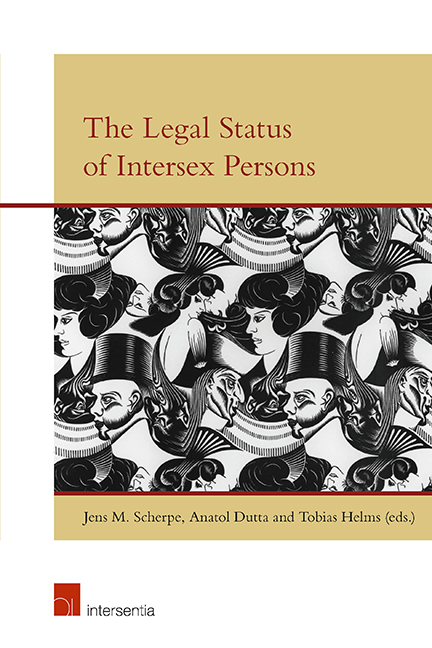Book contents
- Frontmatter
- Preface
- Contents
- List of Contributors
- The Legal Status of Intersex Persons: An Introduction
- Malta Declaration
- Darlington Statement
- Vienna Statement
- PART I MEDICINE AND PSYCHOLOGY
- PART II THEOLOGY AND LEGAL HISTORY
- PART III TRANSGENDER, TRANSSEXUALITY AND INTERSEX
- Lessons from the Legal Development of the Legal Status of Transsexual and Transgender Persons
- Towards Trans and Intersex Equality: Conflict or Complementarity?
- PART IV NATIONAL LEGAL DEVELOPMENTS
- PART V PRIVATE INTERNATIONAL LAW ASPECTS OF INTERSEX
- PART VI INTERSEX AND HUMAN RIGHTS
Towards Trans and Intersex Equality: Conflict or Complementarity?
from PART III - TRANSGENDER, TRANSSEXUALITY AND INTERSEX
Published online by Cambridge University Press: 31 January 2019
- Frontmatter
- Preface
- Contents
- List of Contributors
- The Legal Status of Intersex Persons: An Introduction
- Malta Declaration
- Darlington Statement
- Vienna Statement
- PART I MEDICINE AND PSYCHOLOGY
- PART II THEOLOGY AND LEGAL HISTORY
- PART III TRANSGENDER, TRANSSEXUALITY AND INTERSEX
- Lessons from the Legal Development of the Legal Status of Transsexual and Transgender Persons
- Towards Trans and Intersex Equality: Conflict or Complementarity?
- PART IV NATIONAL LEGAL DEVELOPMENTS
- PART V PRIVATE INTERNATIONAL LAW ASPECTS OF INTERSEX
- PART VI INTERSEX AND HUMAN RIGHTS
Summary
INTRODUCTION
In recent years, the rights and experiences of transgender (‘trans’) individuals have gained increasing legal, political and social visibility. In the United Kingdom, the landmark Gender Recognition Act 2004 (‘ the 2004 Act’ ) transformed the relationship between trans identities and the law, and began (what is now) a global movement towards affirming individuals ‘preferred gender in a more humane and dignified manner. The emergence of high-profile trans personalities, such as Laverne Cox, Caitlyn Jenner and Chelsea Manning, has thrust trans and gender non-conforming identities into the media spotlight. While the ensuing press coverage has sometimes reproduced unwelcome social prejudices, which have long characterised public responses to non-cisgender expression, more often than not social commentators now engage with trans identities in a sensitive and respectful tone.
Despite the advances being made in trans consciousness-raising, however, the lived-realities (and, indeed, the very existence) of those who experience intersex variance remains underexplored, both within legal academia and wider social discourse. While well-publicised ‘coming out'stories (such as the personal narrative of model Hanne Gaby Odiele) exist, general public awareness of intersex, and intersex visibility, is significantly lower than compared to knowledge of the trans community. To the extent that, like lesbian, gay and bisexual (LGB) equality, greater legal and social acceptance for trans identities has resulted from increasing social familiarity, populations that experience intersex variance would likely benefit from enhanced protection if both political representatives and the general public better understood intersex realities.
This chapter considers the overlap in modern efforts to secure trans and intersex legal rights. For many scholars, the aims and strategies of these movements appear, at least superficially, as inherently oppositional. Since the 1970s, much trans advocacy has focused on fairer, safer and more affordable access to gender-affirming healthcare. Within global trans communities, there are large numbers of people who seek to affirm their preferred gender through medical transition pathways, aligning their physical bodies with their internalised sense of gender.
- Type
- Chapter
- Information
- The Legal Status of Intersex Persons , pp. 217 - 240Publisher: IntersentiaPrint publication year: 2018
- 2
- Cited by

